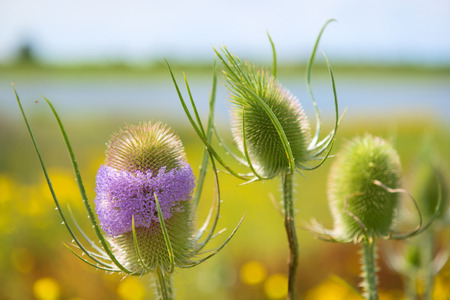Wild Teasel - Dipsacus fullonum

Common Names: Venus’s Bath, Teasel, Wild Teasel, Common Teasel, Dipsacus sylvestris, Dipsacus horridus, Card Thistle, Barber’s Brush, Brushes and Combs, Baignoire de Vénus, wilde Karde, cardaire, Cardo de Cardar, Cabaret des Oiseaux, Cardencha, kardvadd, Dipsacus fullonum
Latin Name: Dipsacus fullonum (sylvestris, horridus)
Origin: Asia, Europe, South America, North America
Short Introduction
The growth habits and appearance of wild and cultivated Wild Teasel differ. Wild Teasel most often grows in slightly moist, nitrogen-rich, fertile, clay-loamy, as well as calcareous and stony soils, but prefers clayey soils. Seeds may be sown outdoors or in situ at the start of spring and transplanted outdoors between February and May. The roots of one-year-old plants are harvested in autumn.
Detailed Description
A natural remedy, not just for Lyme disease!
Botanical Information
Wild Teasel, also known as Common Teasel, is a robust biennial herb that can reach heights up to 2 meters. Its stem is upright, heavily branched and spiny towards the top. The stem leaves are 20-40 cm long and 2-6 cm wide, arranged oppositely, lanceolate, elliptical or egg-shaped, serrated, and sessile; the edges may be hairless. Leaves appear only in the first year and then die back. Flowers are assembled into prickly, erect heads measuring 4-10 cm in length and 3-5 cm in width; corollas are 10-15 mm long, pale purple or white. The plant blooms from July to September. The fruit is an achene.
Origin and Distribution
Today, Wild Teasel occurs naturally in Western, Central, and Southern Europe, the Caucasus, Asia Minor, and as far east as Iran. It has been introduced secondarily to North America (almost every state in the USA) and South America (Uruguay, Argentina, Ecuador). Its original range is believed to include North Africa, Southern Europe, or Southwestern Asia. In the Czech Republic, it is more common in warmer areas from lowlands to highlands; at elevations above 500 meters, it is rare or has completely disappeared. Wild Teasel typically grows in pastures, woodland edges, field edges, embankments, verges, shrublands, wastelands, ruins, and landfills.
Usage / Dosage
Historically, Teasel was widely used in fiber processing as a natural comb to clean, align and raise the nap of fabrics, especially wool. Sometimes grown ornamentally, the dried flower heads are also popular in floristry and as decorations in wreaths. Folk tradition once called the plant "Venus's Bath" for its beauty-enhancing reputation after washing with teasel. Traditionally, it was used topically to treat minor injuries, fistulas, and cancerous growths.
The root is classified in pharmacognosy as a diaphoretic, diuretic, and stomachic. For medicinal purposes, both the aerial parts and root are collected, ideally during summer; roots are best gathered in autumn. Scientific studies have tested Teasel’s chemical compounds in vitro and in vivo for efficacy in arthritic inflammation, psoriatic lesions, and minor wounds, with only modest results. However, other findings are more promising.
The compounds in Wild Teasel appear to help with Lyme disease and viral infections (herpes and more). Analyses have confirmed 23 active derivatives with bacteriostatic effects. Two lipophilic extracts (ethanol and ethyl acetate) have shown significant in vitro inhibitory effects against the growth of spirochetes. Moreover, the challenging or inadequate antibiotic treatment of Borrelia Sp. makes herbal therapy with Teasel a well-tolerated and effective option!
A review describes the in vitro effectiveness of teasel’s compounds and many others against active and latent forms of Borrelia burgdorferi. Many (including those in teasel) show promise as a basis for natural remedies against Lyme disease and other bacterial G+ and G− species, even if it is unclear whether the effect is strictly bacteriostatic or bactericidal.
Traditional and Folk Use
Teasel is used both externally and internally. Externally, compresses or baths made from its root are applied for cracked skin, lips, eczema, inflammatory conditions, acne, rheumatoid arthritis, and skin tumors. Folk medicine also recommends teasel for warts, as a diaphoretic, and in homeopathy. Internally, a decoction is used for urinary retention, inflammatory digestive tract conditions, ulcers, gout, and formerly for tuberculosis. Herbal infusions have traditionally been consumed by those seeking a detoxifier, thought to cleanse the body through sweat glands, urine, and bile.
Active Compounds
The root of Wild Teasel contains alkaloids, essential oils, resins, flavonoids (baicalein, monolaurin, luteolin), tannins, bitters, iridoids, saponins, caffeic acid derivatives, apigenin, malvidin, viniferin, hydroxytyrosol, decenoic acid, minerals, fatty acids, and an interesting glycoside named scabioside.
Traditional Dosage
For immune support, 2-5 grams of teasel root is steeped in 250 ml boiling water for 10 minutes. Drink this bitter tea up to 3 times daily. Tinctures can be made by soaking chopped root in 60% alcohol in a warm, dark place for about a month. Folk medicine recommends 5-15 drops of this tincture, 2-3 times a day.
To prepare a decoction, simmer 1 tablespoon of root in 750 ml water for 3–5 minutes; divide this amount into three doses for use throughout the day.


